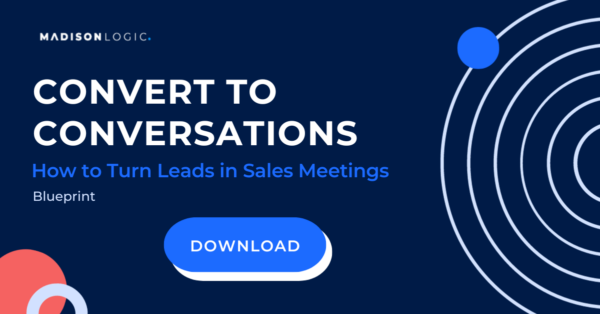
How to Create Content & Messaging That Accelerates the Buying Journey

The B2B buying journey has changed. Buying committee members for complex technical solutions are more independent in their decision-making and conduct more of their own research online.
According to Gartner data, sales teams have limited access to customers during the B2B buying journey, roughly accounting for only 5% of the customers’ time. This leaves it up to marketers to provide account-based marketing (ABM) content and messaging that gets buyers to realize not only what a viable solution looks like, but that you know them and their intent—their “why”—for looking up your product in the first place.
Your ABM content and messaging not only needs to demonstrate your industry leadership, but also create a sense of urgency around the problem so they choose you as the solution that will solve it. Here’s how.
Empower Buyers with Education
As a marketer, your goal is to empower buying committee members throughout their independent buying journey. When a committee member downloads a single piece of content, they’re just becoming acquainted with your brand and solution—particularly if it’s top-of-funnel (TOFU) content like an infographic, social media post (especially on LinkedIn, where target accounts are most likely to already be interacting with similar brands), blog article, white paper, or eBook. Don’t jump directly into what your company offers—start with what problem you solve for them and offer education that helps them make an informed decision. Put that decision-maker’s search for answers and information at the center of all your content communication, rather than your business or brand. If they find your content helpful, they’re more likely to speak with you.
Focus on Building Brand Value and Trust
Buyers are more than just a means to your bottom-line numbers—they’re people looking for solutions. Use your content and messaging to create a positive experience, especially if they’re engaging with TOFU or middle-of-funnel (MOFU) content, like webinars, case studies, and comparison guides. When your messaging reaches the buyer at the right moment with the right information and insight, it feels like you know exactly what they’re looking for—which establishes a deeper sense of trust.
Appeal to Buyer Emotions
Intent data reveals your audience’s behaviors—and behaviors influence actions. Buyers, especially in the discovery and research phases of the buyer’s journey, are most likely downloading plenty of assets from you and competitors. Your content needs to stand out—and you can get there by appealing to your audience’s emotions.
People remember how they feel as they read (“Wow, that was really insightful!” or “I learned something!”) versus the details of what they read. If you create an emotional bond with your lead, you continue to set a strong foundation to establish trust between your company and the buyer, so they’ll be more inclined to hop on the phone with your sales team.
Personalize Content to the Buyer Persona
Sales and marketing alignment begins with asking insightful questions around what both the sales and marketing teams consider to be high–value accounts. This discussion informs your ideal customer profile (ICP), which allows you to build your target account lists with clarity as to who you’re targeting across the entire account. With this deeper understanding of your buyer personas and target accounts, you can easily personalize content to the buyer persona.
The person most likely to take the first sales call is the end user, who will benefit most from using your product or service in their everyday workflows. That said, the end user isn’t the only person making a buying decision. They’re part of a group of buyers—an account—who have different concerns and questions when it comes to buying new software or products. Because of these various concerns, you need to customize your content to address the specific concerns of each persona.

What matters to an executive may not matter to an end user, so create separate ABM campaigns for each persona as opposed to treating the entire account the same way. Even if the inbound leads came from the same piece of content, they’re likely considering the content and messaging in different ways—ways that are unique to their roles within the company.
Anticipate Buying Committee Members Not on Your Radar
Gartner notes that six to ten decision-makers make up the typical buying committee for a complex B2B solution. With the rise in independent research, you can expect each of these decision-makers to have four or five pieces of information that they’ll bring to committee meetings.
An effective ABM strategy doesn’t consider success as reaching just one decision-maker—you need to nurture the full buying committee. Your content needs to speak to buying-committee members you’re unaware of—the ones who haven’t submitted a form for content but may be getting links and intel from the person who is advocating for your product.
Your ABM content strategy should always consider how your content educates, motivates, and persuades readers to take the next action. You need to anticipate blockers, especially as decision-makers prioritize their concerns or consider product features. Knowing who is part of the buying committee allows you to identify and target blockers and product champions with ABM content and messaging that not only addresses their pain points, but offers exactly how your product addresses them.

Measure Engagement and Make Room for Improvements
You need a robust framework for evaluating how your content and messaging influences engagement and conversions. Utilizing advanced analytics and tools allows for a granular analysis of how content influences engagement metrics and conversion rates. Key performance indicators (KPIs) such as click-through rate, time spent on page, and the progression of leads through the sales funnel offer valuable insights into content effectiveness. This data not only reveals which pieces of content are resonating with your audience but also helps you identify areas in the journey where buyers may be stalling.
Adapting your content marketing strategy based on these insights is critical. For instance, if analytics indicate that prospects are spending less time on decision-phase content, it may signal a need for more compelling case studies or testimonials. Conversely, high engagement with awareness-phase content suggests your educational materials are hitting the mark, but you may need to refine how you transition these engaged prospects to the next phase.
Regular review sessions to analyze performance against set objectives help pinpoint specific content pieces or strategies that drive the buying journey forward most effectively. This iterative process of testing, learning, and refining ensures that your content strategy remains dynamic and aligned with your audience’s evolving needs, ultimately streamlining their path to purchase.
Ready, Set, Accelerate
Buyers get stuck in the pipeline for a number of reasons—it’s up to you to motivate them through the sales process faster. Generating enough interest to drive sales engagement comes down to how well you:
- Demonstrate that you understand the buyer’s concerns
- Create a sense of urgency around solving their concerns
- Separate your product or service from competitors
- Understand their buying behaviors and your sales cycle
With more persuasive content and messaging tailored to resonate with buyers at each phase of the decision-making process, you can significantly shorten the path to purchase. It’s about meeting your audience where they are, with the right message at the right time. As you refine your marketing approach and align more closely with your audience’s needs and behaviors, you’ll not only speed up their buying journey but also build lasting relationships that foster loyalty and advocacy for your brand. In a marketplace crowded with options, your ability to effectively communicate and connect can set you apart, turning potential customers into champions of your brand.
Want more information to help you move your leads to sales meetings faster?
Download the Convert to Conversations: How to Turn Leads into Sales Meetings Blueprint to learn how to develop a strong, repeatable approach to your campaign strategies that motivates buyers to take a demo or meeting. Use it as a guide to evaluate your current workflow or identify areas where you can level up.


